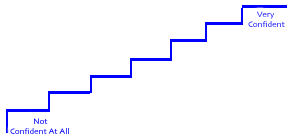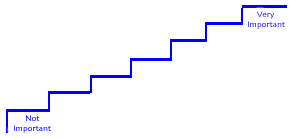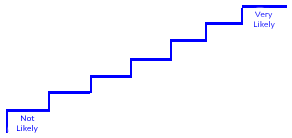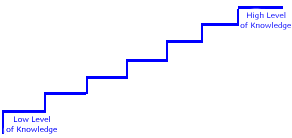December 2000 // Volume 38 // Number 6 // Tools of the Trade // 6TOT2
A Technique to Measure Opinions, Skills, Intentions, and Behaviors That's Different-Even Fun
Abstract
This article introduces a fun and graphic approach to measuring opinions, skill levels, intentions for practice change, and knowledge--a step scale. You can use the approach with youth, adapt it for low literacy and non-English speaking audiences, and use it to collect data at more than one point in time. The article describes construction of the scale and analysis of data and provides examples from an actual program.
You can measure program changes using a graphic such as a series of steps, pictured below in the "Examples" section. This step-scale measure is thought provoking and offers a fresh approach to evaluation for program participants.
A step scale measure has several benefits. It:
- Can increase the validity of data by providing a larger number of answer choices.
- Allows you to collect data at one time point or, as the examples below demonstrate, at two time points, BEFORE and AFTER a program.
- Can be adapted for youth.
- Can be used successfully with low literacy audiences. (For example, put the graphic on a flip chart or overhead to explain how to fill it in; give each participant his or her own copy of the graphic; ask the question orally; and then have participants mark their own graphics.)
To Construct a Step Scale
- Consider the question you want to ask.
- Decide on the number of points you want in the scale, anywhere from 7 to 11. Answer scales with more points can register subtle differences among people. They are very useful in program evaluation, because they offer the opportunity for respondents to indicate small and moderate change, often very difficult to measure.
- Label the bottom and top of the scale to represent each end of the continuum of the answer you are measuring, for example, "not confident at all" and "very confident."
- Provide directions orally or in written form.
- Enlarge the graphic to the width of your paper.
To Analyze Data
Assign each step on the scale a consecutive value: one, two, three, four, etc. Enter individual responses into a computer and analyze as nominal, ordinal, or continuous data. You can find the percent of participants who increased one, two, or more steps. You can also compare BEFORE and AFTER results.
Examples
Below are examples using a step scale to collect evaluation data in a water quality program at two points in time: BEFORE and AFTER the program on a skill, attitude about a recommended solution, intention to use a recommended practice, and knowledge of a solution.
Perceived Skill
Please place a (B) on the step signifying how confident you felt about your ability to divert rain from paved surfaces BEFORE the workshop. Place an (A) on the step indicating how confident you feel about your ability to divert rain from paved surfaces now, AFTER the workshop.

Attitude About a Recommended Solution
Please place a (B) on the step signifying how important you thought diverting rain from paved surfaces was BEFORE the workshop. Place an (A) on the step that indicates how important you believe diverting rain from paved surfaces is now, AFTER the workshop.

Intention to Use Recommended Practice
Please place a (B) on the step signifying how likely you were to divert rain from paved surfaces BEFORE the workshop. Place an (A) on the step indicating how likely you are to divert rain from paved surfaces now, AFTER the workshop.

Knowledge of a Solution
Please place a (B) on the step signifying your level of understanding about erosion prevention BEFORE the workshop. Place an (A) on the step indicating your level of understanding now, AFTER the workshop.

